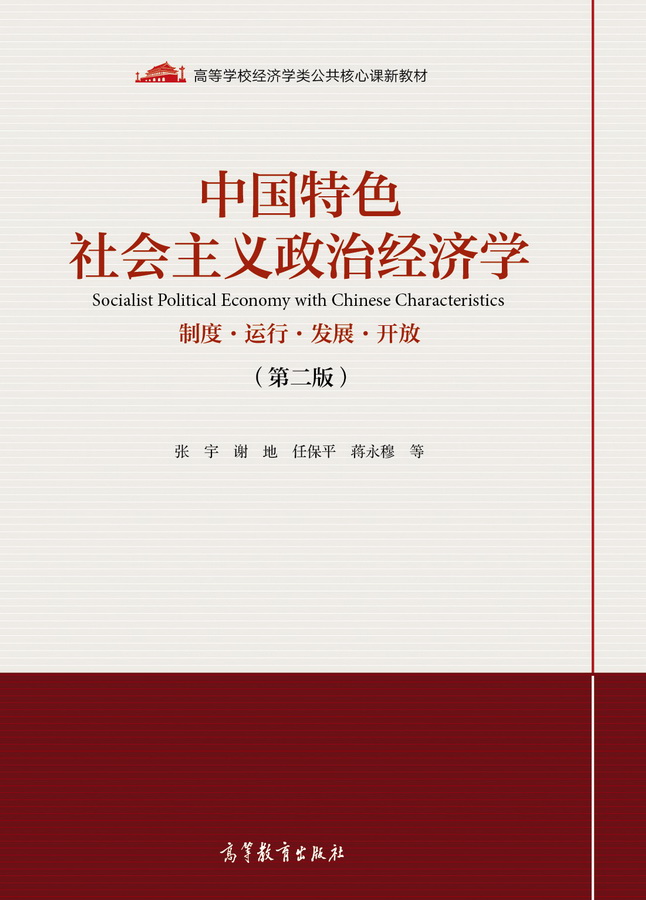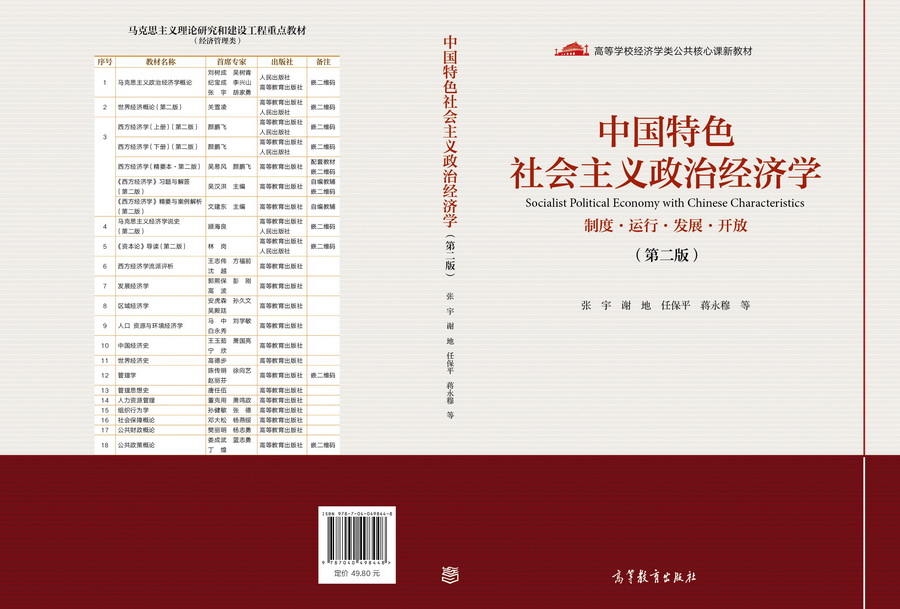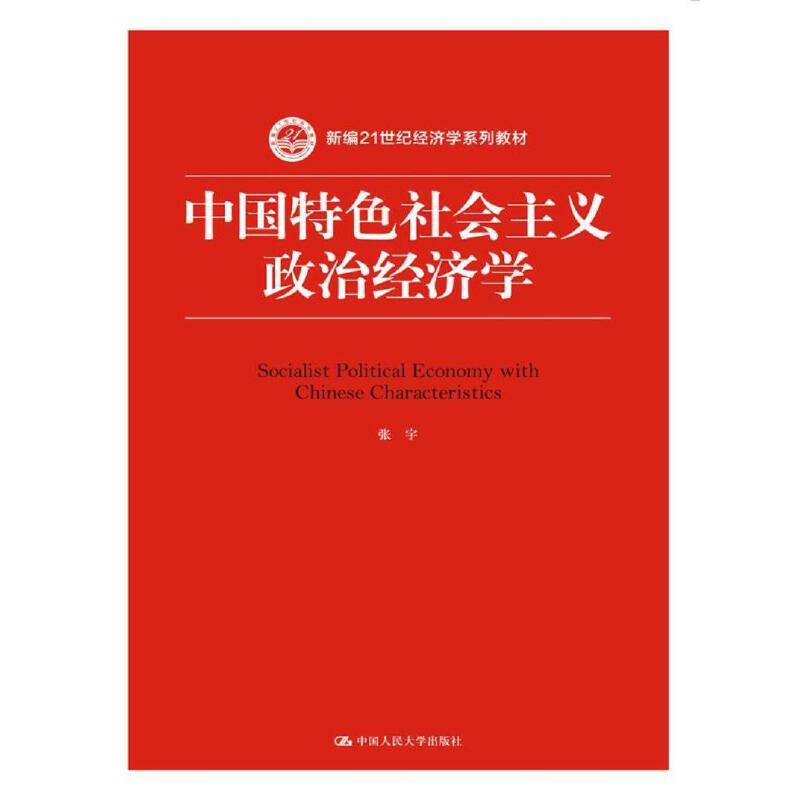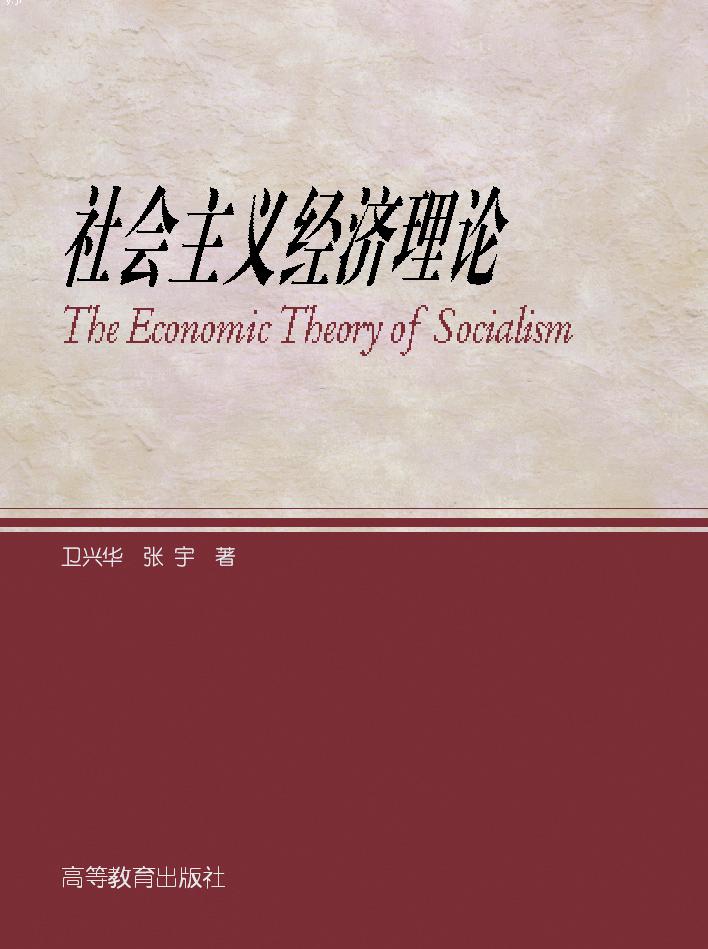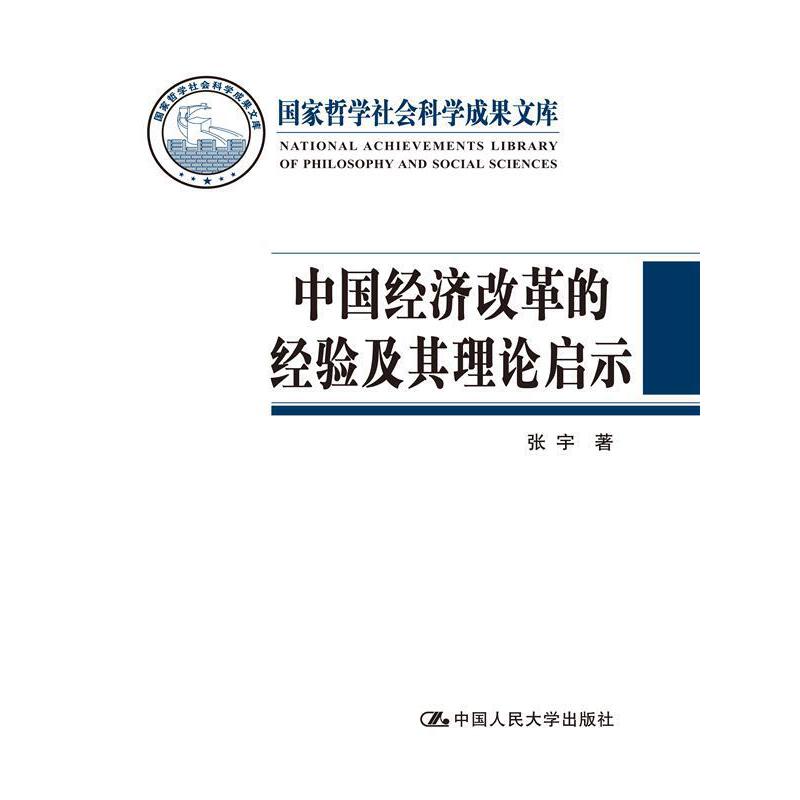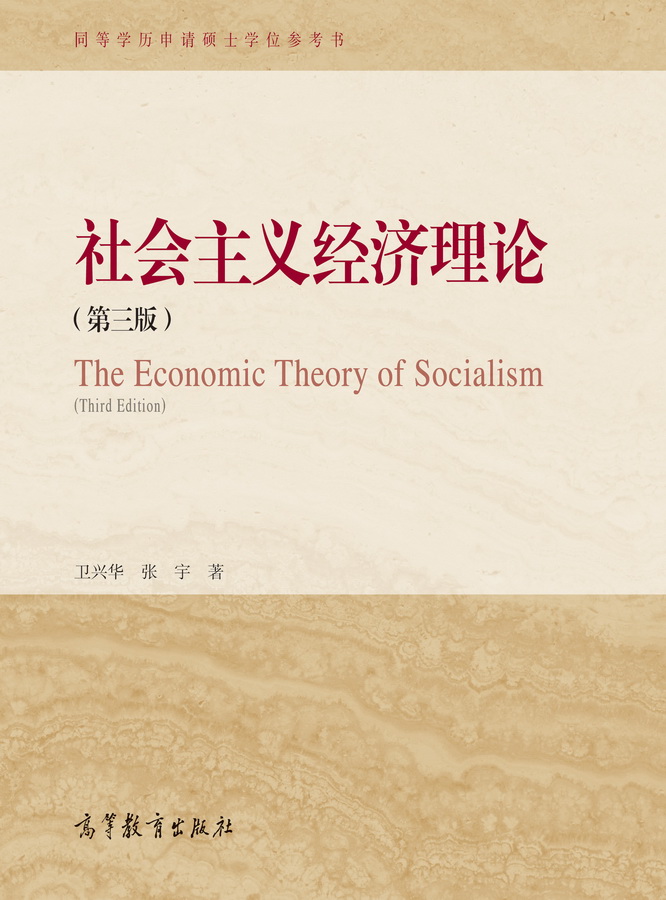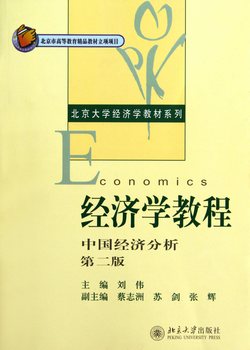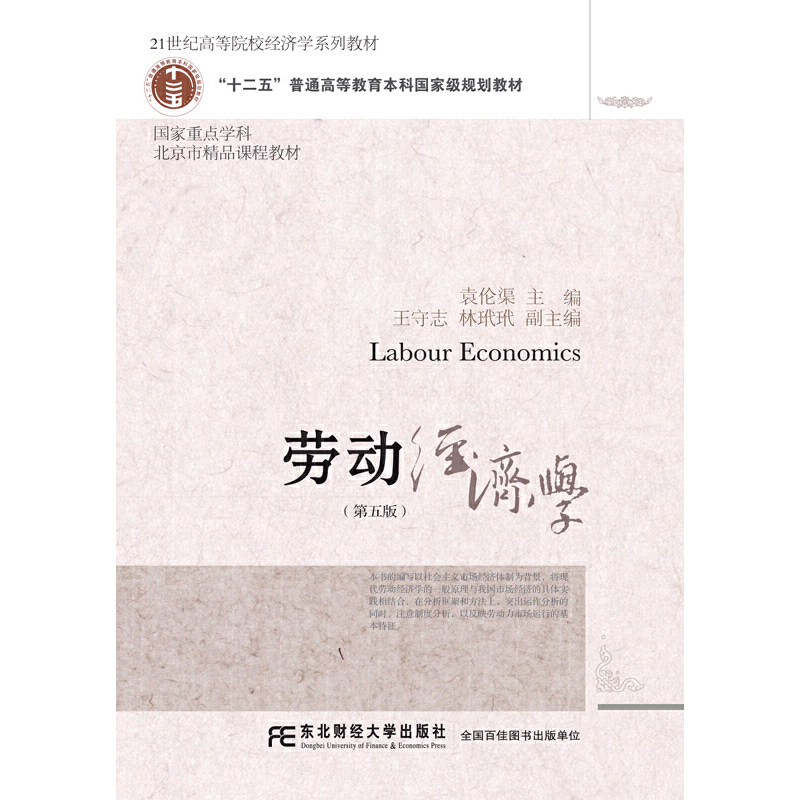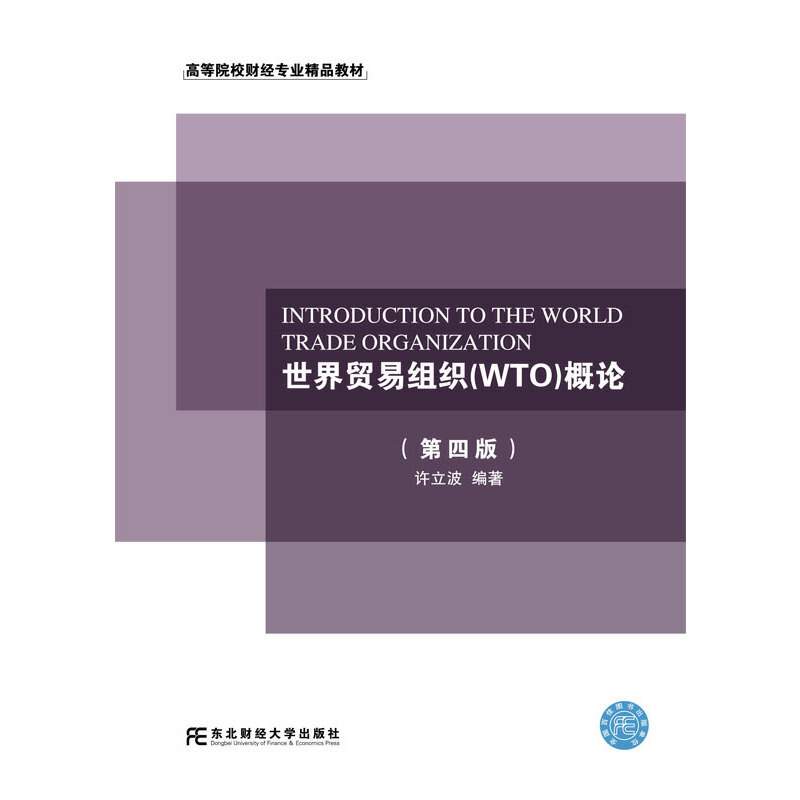中国特色社会主义政治经济学(第二版)
作者: 张宇、蒋永穆、谢地、任保平
出版时间:2018-06-30
出版社:高等教育出版社
- 高等教育出版社
- 9787040498448
- 2
- 229741
- 40214128-7
- 平装
- 16开
- 2018-06-30
- 580
- 188
- 经济学
- 理论经济学
- 经济学类核心课程
- 本科
中国特色社会主义政治经济学,是马克思主义政治经济学基本理论与改革开放实践相结合的理论成果,是当代中国马克思主义政治经济学的集中体现,是指导中国特色社会主义经济建设的理论基础。党的十八大以来,习近平总书记多次强调,要坚持发展中国特色社会主义政治经济学,不断完善中国特色社会主义政治经济学理论体系。本书在吸取和借鉴以往研究成果的基础上,立足中国国情和发展实践,提出了制度、运行、发展、开放四位一体的中国特色社会主义政治经济学理论体系,阐述了中国特色社会主义政治经济学的基本理论及其最新成果,阐述了新时代中国特色社会主义经济理论和实践发展的一系列重大问题,揭示了中国特色社会主义经济的本质特征和运动规律。
本书除可作为全国高等学校经济学类专业核心课教材外,也可供相关研究和理论学习参考。
导 论Introduction
第一节 什么是中国特色社会主义政治经济学What Is Socialist Political Economy with Chinese Characteristics
一、经济学和政治经济学Economics and Political Economy
二、马克思主义政治经济学arxian Political Economy
三、社会主义政治经济学Socialist Political Economy
四、中国特色社会主义政治经济学Socialist Political Economy with Chinese Characteristics
五、学习中国特色社会主义政治经济学的重要意义The Importance of Learning Socialist Political Economy with Chinese Characteristics
第二节 中国特色社会主义政治经济学的产生和发展The Establishment and Development of Socialist Political Economy with Chinese Characteristics
一、社会主义政治经济学的奠基The Foundation of Socialist Political Economy
二、社会主义政治经济学的创立The Establishment of Socialist Political Economy
三、对中国社会主义政治经济学的探索Explorations in Socialist Political Economy with Chinese Characteristics
四、中国特色社会主义政治经济学的形成发展The Establishment and Development of Socialist Political Economy with Chinese Characteristics
五、中国特色社会主义政治经济学的最新成果Recent Contributions in Socialist Political Economy with Chinese Characteristics
第三节 中国特色社会主义政治经济学的性质The Nature of the Socialist Political Economy with Chinese Characteristics
一、科学性与人民性相统一Integration of Being Scientific and Being People-Centered
二、经济与政治相统一Integration of the Economy and Politics
三、社会主义与市场经济相统一Integration of Socialism and the Market Economy
四、民族性与世界性相统一Integration of Standing on Our Nation and Achieving Worldwide Significance
第四节 发展中国特色社会主义政治经济学的原则The Theoretical Basis and Resources of the Socialist Political Economy with Chinese Characteristics
一、以马克思主义为指导The Guidance of Marxism
二、正确借鉴西方经济学To Critically Learn from Western Economics
三、吸收中华优秀文化To Integrate the Chinese Outstanding Culture
四、立足中国国情和实践Based on the National Conditions and Practice of China
第一篇 中国特色社会主义经济制度Part One:Socialist Economic Systems with Chinese Characteristics
第一章 社会主义基本经济制度Chapter 1 The Basic Economic System of the Primary Stage of Socialism
第一节 社会主义经济制度的建立及其成就The Establishment and Achievements of the Socialist Economic System
一、社会主义经济制度的建立The Establishment of the Socialist Economic System
二、社会主义经济制度在中国的建立The Establishment of the Socialist Economic System in China
三、社会主义经济制度优越性的初步体现Preliminary Manifestation of the Systematic Superiority of the Socialist Economy
第二节 中国特色社会主义经济制度The Socialist Economic System with Chinese Characteristics
一、社会主义初级阶段The Primary Stage of Socialism
二、中国特色社会主义新时代The New Era of Socialism with Chinese Characteristics
三、中国特色社会主义经济制度的确立The Establishment of the Socialist Economic System with Chinese Characteristics
四、中国特色社会主义经济制度的构成及其成熟定型The Configuration and Maturation of the Socialist Economic System with Chinese Characteristics
第三节 社会主义初级阶段基本经济制度The Basic Economic System of the Primary Stage of Socialism
一、基本经济制度的确立和发展The Establishment and Development of the Basic Economic System
二、基本经济制度的内涵Connotations of the Basic Economic System
三、基本经济制度的实现形式Forms of the Realization of the Basic Economic System
第四节 公有制经济的主体地位The Mainstay Status of the Public Ownership Economy
一、为什么坚持以公有制为主体Why China Upholds the Mainstay Status of Public Ownership
二、公有制的具体形式Concrete Forms of Public Ownership
三、以公有制为主体的含义Implications of the Mainstay Status of Public Ownership
四、社会主义公有制生产关系的特征Characteristics of the Relations of Production in the Socialist Public Ownership Economy
五、社会主义生产目的Purposes of Socialist Production
六、国有经济的主导作用The Leading Role of the State-owned Economy
七、做强做优做大国有企业和国有资本Making State-owned Enterprises Stronger,Better,and Bigger and the Concept of State Capital
八、农村集体所有制Rural Collective Ownership
第五节 积极发展非公有制经济To Actively Develop the Non-public Ownership Economy
一、非公有制经济的内涵The Connotations of the Non-public Ownership Economy
二、非公有制经济的地位和作用The Position and Role of the Non-public Ownership Economy
三、促进非公有制经济的健康发展To Promote the Development of the Non-public Ownership Economy
第二章 社会主义市场经济制度Chapter 2 The Socialist Market Economy System
第一节 社会主义市场经济的性质The Nature of the Socialist Market Economy
一、制度与体制:社会主义市场经济的两个层面Systems versus Structures:Two Levels of the Socialist Market Economy
二、社会主义与市场经济相结合的依据The Basis for the Integration between Socialism and the Market Economy
三、市场经济的社会属性The Social Nature of the Market Economy
第二节 社会主义市场经济对资本主义市场经济的超越The Superiority of the Socialist Market Economy Relative to a Capitalist Market Economy
一、资本主义市场经济的弊端Problems with the Capitalist Market Economy
二、社会主义市场经济的制度优势The Systematic Superiority of the Socialist Market Economy
三、把社会主义与市场经济更好地结合起来To Better Integrate Socialism and the Market Economy
第三节 社会主义市场经济中的政府和市场关系Relations between Governments and Markets in the Socialist Market Economy
一、对政府和市场关系认识的发展The Development of the Understanding of the Relations between Governments and Markets
二、市场在资源配置中起决定性作用The Decisive Role of Markets in Resource Allocation
三、更好发挥政府作用To Make Governments Better Play Their Roles
四、坚持党对经济工作的集中统一领导To Uphold the Unified Leadership of the Chinese Communist Party in Economic Affairs
五、有效市场 有为政府Efficient Markets and Effective Governments
第四节 社会主义经济体制改革Economic Structural Reforms of Socialism
一、基本经济制度与经济体制The Basic Economic System and the Economic Structure
二、经济体制改革的性质和目标The Nature and Goals of Economic Structural Reform
三、中国的渐进式改革道路China’s Gradualist Reform Path
第三章 社会主义基本分配制度Chapter 3 The Basic Distribution System of the Primary Stage of Socialism
第一节 按劳分配Distribution according to Work
一、马克思主义视野中的分配Distribution in the Marxian Perspective
二、社会主义按劳分配The Socialist Principle of “Distribution according to Work”
三、按劳分配与市场经济“Distribution according to Work”and the Market Economy
四、社会主义市场经济中按劳分配的实现The Realization of “Distribution according to Work”in the Socialist Market Economy
五、以按劳分配为主体The Mainstay Status of “Distribution according to Work”
第二节 多种分配方式并存The Coexistence of Diverse Modes of Distribution
一、多种分配方式的形成The Formation of Diverse Modes of Distribution
二、按生产要素分配Distribution according to Factors of Production
三、按需分配Modes of Distribution for the Common Satisfaction of Needs
第三节 实现全体社会成员共同富裕To Achieve Common Prosperity for all Members in the Society
一、共同富裕是社会主义的本质要求Common Prosperity is the Fundamental Requirement of Socialism
二、居民财产差距与收入差距Wealth Inequality and Income Inequality
三、提高劳动报酬的占比To Increase the Share of Labor Compensation in National Income
第四节 效率和公平Efficiency versus Equity
一、社会主义市场经济中的公平原则The Equity Principle in the Socialist Market Economy
二、效率和公平的关系Relations between Efficiency and Equity
三、初次分配和再分配都要处理好效率和公平关系To Well Handle the Relations between Efficiency and Equity in both Primary Distribution and Redistribution
第二篇 中国特色社会主义经济运行Part Two:The Operation of the Socialist Economy with Chinese Characteristics
第四章 微观经济运行Chapter 4 Microeconomic Operation
第一节 微观经济运行过程The Micro Economy
一、微观经济与宏观经济的区分The Micro Economy versus the Macro Economy
二、微观经济运行的主体Subjects in Microeconomic Operation
三、微观经济活动的内容Contents of Microeconomic Activities
四、微观经济运行机理Mechanisms of Microeconomic Operation
第二节 国有企业的经济活动Economic Activities of State-owned Enterprises
一、国有企业的双重属性The Double Attribute of State-owned Enterprises
二、国有企业经济活动的目标Goals of the Economic Activities of State-owned Enterprises
三、国有企业的分类The Classification of State-owned Enterprises
四、国有企业的效率The Efficiency of State-owned Enterprises
第三节 非公有制企业的经济活动Economic Activities of Non-public Enterprises
一、非公有制企业的发展轨迹The Development History of Non-public Enterprises
二、私营企业的经济活动Economic Activities of Private Enterprises
三、外资企业的经济活动Economic Activities of Foreign-funded Enterprises
四、个体企业的经济活动Economic Activities of Self-employed Enterprises
第四节 农户的经济活动Economic Activities of Rural Households
一、农户的地位The Position of Rural Households
二、农户的生产活动Production Activities of Rural Households
三、农户的消费活动Consumption Activities of Rural Households
第五节 居民的经济活动Economic Activities of Residents
一、居民收入行为The Income of Residents
二、居民消费行为The Consumption Behaviors of Residents
三、居民储蓄及投资行为The Saving and Investment Behaviors of Residents
第六节 微观监管Micro Regulations
一、微观监管的依据The Basis of Micro Regulations
二、社会主义市场经济中微观监管的特点Characteristics of the Micro Regulations in China
三、完善微观监管体系To Improve the Micro Regulation System
第五章 中观经济运行Chapter 5 Mesoeconomic Operation
第一节 中观经济的内容和意义Contents and Implications of the Meso Economy
一、中观经济的提出The Meso Economy
二、中国中观经济的特征Characteristics of China’s Meso Economy
三、中观经济的作用Roles of the Meso Economy
第二节 产业经济活动Industrial Economic Activities
一、产业的划分The Classification of Industries
二、产业结构高级化To Upgrade the Industrial Structure
三、产业组织Industrial Organization
四、产业政策Industrial Policies
第三节 区域经济活动Regional Economic Activities
一、区域经济层级及其特征Levels and Characteristics of the Regional Economy
二、区域经济布局The Distribution of the Regional Economy
三、区域经济发展战略Strategies for Regional Economic Development
第四节 地方政府的经济行为Economic Behaviors of Local Governments
一、中央和地方关系的定位Relations between the Central Government and Local Governments
二、中央政府和地方政府关系的演变Changes in the Relations between the Central Government and Local Governments
三、地方政府的作用Roles of Local Governments
第六章 宏观经济运行Chapter 6 Macroeconomic Operation
第一节 社会产品的总供给与总需求平衡关系The Balance between the Aggregate Supply and Aggregate Demand of Social Products
一、马克思主义视野中的宏观经济运行Macroeconomic Operation in the Marxian Perspective
二、总供给与总需求Aggregate Supply and Aggregate Demand
三、总量平衡与结构平衡Aggregate Balance and Structural Balance
第二节 总量管理与结构管理Aggregate Management and Structural Management
一、需求总量管理The Management of Aggregate Demand
二、需求结构管理The Management of the Demand Structure
三、供给结构管理The Management of the Supply Structure
第三节 宏观经济波动Macroeconomic Fluctuations
一、宏观经济波动原因的一般解释The General Explanation to Macroeconomic Fluctuations
二、中国宏观经济波动的原因Reasons for the Macroeconomic Fluctuations in China
三、改革开放以来中国宏观经济的波动Macroeconomic Fluctuations in China since the Reform and Opening-up Policy
第四节 中国宏观调控的模式Modes of the Macro Regulations in China
一、宏观调控的特征Characteristics of the Macro Regulations
二、宏观调控的经验Experience of the Macro Regulations
三、宏观调控的目标Goals of the Macro Regulations
四、宏观调控的手段Means of the Macro Regulations
第三篇 中国特色社会主义经济发展Part Three:Socialist Economic Development with Chinese Characteristics
第七章 社会主义经济增长Chapter 7 Socialist Economic Growth
第一节 社会主义经济增长的实质The Nature of Socialist Economic Growth
一、马克思主义视野中的经济增长Economic Growth in the Marxian Perspective
二、资本主义经济增长的成就与局限Achievements and Limits of Capitalist Economic Growth
三、社会主义经济增长的特点Characteristics of Socialist Economic Growth
第二节 中国经济的持续高速增长Continuously Rapid Growth of the Chinese Economy
一、改革开放前的经济增长China’s Economic Growth before 1978
二、中国经济增长的奇迹The Miracle of China’s Economic Growth
三、中国经济增长的优势Advantages of China’s Economic Growth
第三节 新常态下的经济增长Economic Growth in the New Normal
一、经济增长速度的变化Changes in the Speed of Economic Growth
二、经济增长速度变化的原因Reasons for the Changes in the Speed of Economic Growth
三、深入推进供给侧结构改革To Deepen and Push Forward the Supply-side Structural Reform
第四节 经济增长的数量、质量和效益的统一Unifying the Quantity,Quality,and Benefits of Economic Growth
一、经济增长数量和质量的关系Relations between the Quantity and Quality of Economic Growth
二、经济增长数量和效益的关系Relations between the Quantity and Benefits of Economic Growth
三、经济增长质量和效益的关系Relations between the Quality and Benefits of Economic Growth
第八章 社会主义经济发展Chapter 8 Socialist Economic Development
第一节 经济发展实质The Nature of Economic Development
一、经济发展的内涵Connotations of Economic Development
二、实现以人民为中心的经济发展To Achieve the People-centered Economic Development
三、实现经济的科学发展To Achieve the Scientific Development of the Economy
四、贯彻新发展理念To Implement the New Development Concepts
第二节 经济发展战略Strategies for Economic Development
一、三步走战略The Three-step Development Strategy
二、建设小康社会战略The Strategy of Building a Well-off Society
三、分两阶段实现现代化战略The Strategy of Achieving Modernization through Two Stages
四、科教兴国战略和人才强国战略The Strategies of Rejuvenating the Country through Science and Education and Strengthening the Country through Human Resource Development
五、创新驱动发展战略The Strategy of Innovation-driven Development
六、乡村振兴战略The Strategy of Rural Revitalization
第三节 推进高质量发展To Push Forward High-quality Development
一、推动我国经济高质量发展的重大意义The Crucial Significance of Pushing Forward High-quality Development
二、高质量发展的基本内涵Connotations of High-quality Development
三、建立现代化经济体系To Establish a Modern Economic System
第四节 经济发展方式Economic Development Modes
一、经济发展方式的内涵与类型Connotations and Types of Economic Development Modes
二、经济发展方式转变To Transform the Economic Development Mode
第五节 中国特色经济发展道路The Economic Development Path with Chinese Characteristics
一、中国特色新型工业化道路The New-type Industrialization Path with Chinese Characteristics
二、中国特色自主创新道路The Independent Innovation Path with Chinese Characteristics
三、中国特色农业现代化道路The Agricultural Modernization Path with Chinese Characteristics
四、中国特色新型城镇化道路The New-type Urbanization Path with the Chinese Characteristics
五、中国特色军民融合发展道路The Integrated Military and Civilian Development Path with the Chinese Characteristics
第六节 推进绿色发展To Promote Green Development
一、绿色发展的意义Implications of Green Development
二、绿色发展的基本内涵Connotations of Green Development
三、推进绿色发展的基本要求Basic Requirements for Promoting Green Development
第七节 正确处理虚拟经济与实体经济的关系To Correctly Handle the Relations between the Fictitious Economy and the Real Economy
一、实体经济与虚拟经济的内涵Connotations of the Real Economy and the Fictitious Economy
二、虚拟经济与实体经济的关系Relations between the Fictitious Economy and the Real Economy
三、如何正确处理虚拟经济与实体经济的关系To Correctly Handle the Relations between the Fictitious Economy and the Real Economy
四、大力发展实体经济To Strongly Develop the Real Economy
第九章 城乡一体化发展Chapter 9 Urban-rural Integrated Development
第一节 城乡一体化发展的实质The Nature of Urban-rural Integrated Development
一、马克思主义视野中的城乡一体化发展Urban-rural Integrated Development in the Marxian Perspective
二、中国城乡一体化发展的提出The Background of Urban-rural Integrated Development
三、城乡一体化发展的意义Implications of Urban-rural Integrated Development
第二节 中国城乡一体化发展的演变及其成就The History and Achievements of China’s Urban-rural Integration
一、中国城乡一体化发展的演变和阶段特征The History and Stage Characteristics of China’s Urban-rural Integration
二、中国城乡一体化发展的主要成就Achievements of China’s Urban-rural Integration
三、中国城乡一体化发展存在的主要问题Problems with China’s Urban-rural Integration
第三节 城乡二元经济结构The Urban-rural Dual Structure
一、城乡二元经济结构的含义The Connotations of the Urban-rural Dual Structure
二、城乡二元经济结构的两重成因Two Reasons for the Formation of the Urban-rural Dual Structure
三、中国城乡二元经济结构的成因及演变Reasons for China’s Urban-rural Dual Structure and Its History
四、城乡二元经济结构下农村劳动力转移The Migration of Rural Labor Forces under the Urban-rural Dual Structure
第四节 走城乡融合发展之路To Follow the Path of the Urban-rural Integrated Development
一、新时代中国推动城乡融合发展的主要路径Paths to Promote China’s Urban-rural Integrated Development
二、实现城乡融合发展的政策措施Policies to Achieve China’s Urban-rural Integrated Development
第四篇 中国特色社会主义对外开放Part Four:Socialist Opening Up
第十章 经济全球化与对外开放Chapter 10 Economic Globalization and Opening Up
第一节 经济全球化Economic Globalization
一、经济全球化的内涵与表现The Concept of Economic Globalization and Its Phenomena
二、对经济全球化的不同认识Perspectives on Economic Globalization
三、马克思主义视野中的经济全球化Economic Globalization in the Marxian Perspective
四、探索新型经济全球化道路To Seek a New Mode of Economic Globalization
五、为引导经济全球化健康发展贡献中国智慧To Contribute the Chinese Wisdom for Leading the Development of Economic Globalization
第二节 中国对外开放的历程The History of China’s Opening Up
一、中国对外开放政策的演变Changes in the Opening Up Policies
二、中国对外开放的阶段Four Stages of China’s Opening Up
三、中国对外开放的成就Achievements of China’s Opening Up
第三节 对外开放与独立自主Opening Up and Independence
一、坚持对外开放的基本国策To Uphold the Opening-up Policy
二、把坚持独立自主同参与经济全球化相结合To Integrate Upholding Independence and Participating in Economic Globalization
三、技术自主性Technological Independence
四、产业自主性Industrial Independence
五、金融自主性Financial Independence
六、政策自主性Policy Independence
第十一章 对外经济关系Chapter 11 Foreign Economic Relations
第一节 对外经济关系的实质和特点The Nature and Characteristics of Foreign Economic Relations
一、马克思主义视野中的对外经济关系Foreign Economic Relations in the Marxian Perspective
二、发展对外经济关系的意义The Nature of Foreign Economic Relations
三、对外经济关系的基本形式Basic Forms of Foreign Economic Relations
四、中国对外经济关系发展的历程The History of China’s Foreign Economic Relations
第二节 中国对外经济关系的格局The Structure of China’s Foreign Economic Relations
一、对外经济关系类型The Classification of Foreign Economic Relations
二、双边经济关系Bilateral Economic Relations
三、多边经济关系Multilateral Economic Relations
四、区域经济关系Regional Economic Relations
五、中国参与的国际经济组织International Economic Organizations that China Participates in
第三节 中国同发达国家和地区的对外经济关系China’s Economic Relations with Developed Countries and Regions
一、中国同发达国家和地区对外经济关系的特征Characteristics of China’s Economic Relations with Developed Countries and Regions
二、中国同美国的经济关系China’s Economic Relations with the United States
三、中国同欧盟的经济关系China’s Economic Relations with the European Union
四、中国同日本的经济关系China’s Economic Relations with Japan
第四节 中国同发展中国家和地区的对外经济关系China’s Economic Relations with Developing Countries and Regions
一、中国同发展中国家和地区对外经济关系的特征Characteristics of China’s Economic Relations with Developing Countries and Regions
二、中国同金砖国家的经济关系China’s Economic Relations with Other BRICKS Countries
三、中国—东盟自由贸易区China-ASEAN Free Trade Area
四、中国同非盟的经济关系China’s Economic Relations withthe African Union
五、中国同拉丁美洲的经济关系China’s Economic Relations with Latin America
第十二章 积极参与全球经济治理Chapter 12 Active Participation in Global Economic Governance
第一节 全球经济治理的内涵与演变The Concept and History of Global Economic Governance
一、全球经济治理的提出The Background of Global Economic Governance
二、全球经济治理的内涵Connotations of Global Economic Governance
三、全球经济治理的演变The History of Global Economic Governance
第二节 全球经济治理的内容、特征与问题Contents,Characteristics,and Problems of Global Economic Governance
一、全球经济治理的行为主体Subjects in Global Economic Governance
二、全球经济治理的主要内容Contents of Global Economic Governance
三、全球经济治理的主要特征Characteristics of Global Economic Governance
四、全球经济治理中存在的主要问题Problems of Global Economic Governance
第三节 全球经济治理的中国方案The China Approach for Improving Global Economic Governance
一、以平等为基础The Basis of Equality
二、以开放为导向The Orientation of Opening Up
三、树立正确的义利观To Establish the Correct Justice and Benefit Concepts
四、建立合作共赢的国家关系To Build Cooperative and Win-win Foreign Relations
五、坚持共商、共建、共享的治理理念To Uphold the Governance Concepts of Jointly Discussing,Building, and Sharing
六、构建人类命运共同体To Build a Community with Common Destiny
七、“一带一路”倡议推动全球经济治理建构The “Belt and Road”Initiatives Promote the Construction of the Global Economic Governance
第十三章 坚定中国特色社会主义共同理想和共产主义远大理想Chapter 13 To Uphold the Common Ideal of the Socialism with Chinese Characteristics and the Lofty Ideal of Communism
第一节 从资本主义到共产主义是人类社会发展的方向The Human Society Is Developing from Capitalism to Communism
一、资本主义的历史地位The Historical Position of Capitalism
二、资本主义为共产主义所代替的历史必然性The Historical Necessity of Replacing Capitalism with Socialism
三、从资本主义向共产主义过渡是一个长期的历史过程The Transition from Capitalism to Communism is a Long Historical Process
第二节 当代资本主义的新变化及面临的困境New Changes of Contemporary Capitalism and Its Plight
一、当代资本主义的阶段性特征Stage Characteristics of Contemporary Capitalism
二、资本主义基本矛盾的深化The Deepening of the Capitalist Fundamental Contradiction
三、当代资本主义经济持续停滞的原因Reasons for the Continuous Stagnation of Contemporary Capitalism
四、资本主义向何处去The Future of Capitalism
第三节 共产主义的远大理想必然会实现The Lofty Ideal of Communism Will Come True
一、共产主义的基本特征The Basic Characteristics of Communism
二、共产主义社会是历史发展的必然趋势The Communist Society Is the Inevitable Trend of Historical Development
三、坚定共产主义远大理想和中国特色社会主义共同理想Uphold the Lofty Ideal of Communism and the Common Ideal of Socialism with Chinese Characteristics
主要参考文献Main References
重要术语索引Subject Index

